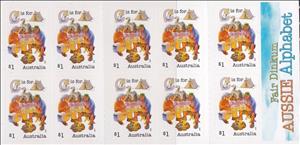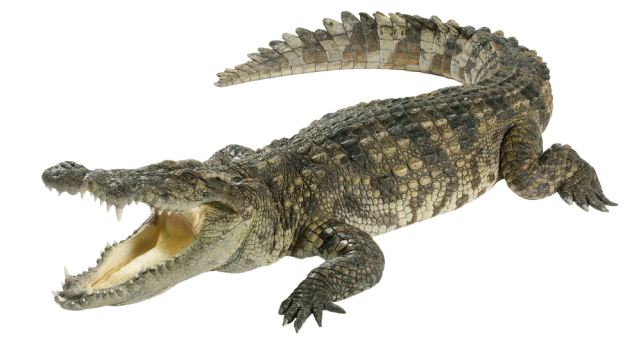Booklet Pane: C is for Camping, Canberra map, crocodile and cockatoo (Australia 2016)
C is for Camping, Canberra map, crocodile and cockatoo (Australia 2016)
16 August (Australia ) within release Fair Dinkum Aussie Alphabet Part 2 goes into circulation Booklet Pane C is for Camping, Canberra map, crocodile and cockatoo face value 10*1 Australian dollar
| Booklet Pane C is for Camping, Canberra map, crocodile and cockatoo in catalogues | |
|---|---|
| Michel: | Mi: AU MH705 |
| Stamp Number: | Sn: AU 4526a |
Booklet Pane is square format.
Booklet pane of 10Also in the issue Fair Dinkum Aussie Alphabet Part 2:
- Stamp - A is for Aussie Rules face value 1;
- Stamp - C is for Camping face value 1;
- Stamp - L is for Lyrebird face value 1;
- Stamp - R is for Refrigerator face value 1;
- Stamp - T is for Tasmania face value 1;
- Stamp - A is for Aussie Rules face value 1;
- Stamp - C is for Camping face value 1;
- Stamp - L is for Lyrebird face value 1;
- Stamp - R is for Refrigerator face value 1;
- Stamp - T is for Tasmania face value 1;
- Booklet Pane - A is for Aussie Rules, Ant, and ANZAC memorial face value 10*1;
- Booklet Pane - T is for Tasmania map, Tasmanian devil, tradesman in tinnie face value 10*1;
- Booklet Pane - C is for Camping, Canberra map, crocodile and cockatoo face value 10*1;
- Booklet Pane - L is for Lyrebird on lounge, Lace monitor, Lamingtons on log face value 10*1;
- Booklet Pane - R is for Refrigerator, Rugby ball, rocket, reel, ruler, rope face value 10*1;
- Se-tenant - Fair Dinkum Aussie Alphabet (Letters A, C, L, R, T) face value 5*1;
- Stamp - L is for Lyrebird on lounge, Lace monitor, Lamingtons on log face value 1;
- Stamp - A is for Aussie Rules, Ant and ANZAC Memorial face value 1;
- Stamp - T is for Tasmania map, Tasmanian devil, tradesman in tinnie face value 1;
- Stamp - C is for Camping, Camberra map, crocodile and cockatoo face value 1;
- Stamp - R is for Refrigerator, Rygby ball, rocket, reel, ruler, rope face value 1;
Booklet Pane C is for Camping, Canberra map, crocodile and cockatoo it reflects the thematic directions:
Animals are multicellular, eukaryotic organisms of the kingdom Animalia (also called Metazoa). All animals are motile, meaning they can move spontaneously and independently, at some point in their lives. Their body plan eventually becomes fixed as they develop, although some undergo a process of metamorphosis later on in their lives. All animals are heterotrophs: they must ingest other organisms or their products for sustenance.
Birds (Aves), a subgroup of Reptiles, are the last living examples of Dinosaurs. They are a group of endothermic vertebrates, characterised by feathers, toothless beaked jaws, the laying of hard-shelled eggs, a high metabolic rate, a four-chambered heart, and a strong yet lightweight skeleton. Birds live worldwide and range in size from the 5 cm (2 in) bee hummingbird to the 2.75 m (9 ft) ostrich. They rank as the class of tetrapods with the most living species, at approximately ten thousand, with more than half of these being passerines, sometimes known as perching birds. Birds are the closest living relatives of crocodilians.
Crocodiles (family Crocodylidae) or true crocodiles are large semiaquatic reptiles that live throughout the tropics in Africa, Asia, the Americas and Australia. The term crocodile is sometimes used even more loosely to include all extant members of the order Crocodilia, which includes the alligators and caimans (family Alligatoridae), the gharial and false gharial (family Gavialidae) among other extinct taxa.
A flame (from Latin flamma) is the visible, gaseous part of a fire. It is caused by a highly exothermic chemical reaction made in a thin zone. When flames are hot enough to have ionized gaseous components of sufficient density, they are then considered plasma.
Headgear may be worn for protection against cold (such as the Canadian tuque), heat, rain and other precipitation, glare, sunburn, sunstroke, dust, contaminants, etc. Helmets are worn for protection in battle or against impact, for instance when riding bicycles or motor vehicles. There are also hats that are worn for protection from the cold
A map is a symbolic depiction emphasizing relationships between elements of some space, such as objects, regions, or themes. Many maps are static, fixed to paper or some other durable medium, while others are dynamic or interactive. Although most commonly used to depict geography, maps may represent any space, real or imagined, without regard to context or scale, such as in brain mapping, DNA mapping, or computer network topology mapping. The space being mapped may be two dimensional, such as the surface of the earth, three dimensional, such as the interior of the earth, or even more abstract spaces of any dimension, such as arise in modeling phenomena having many independent variables. Although the earliest maps known are of the heavens, geographic maps of territory have a very long tradition and exist from ancient times. The word "map" comes from the medieval Latin Mappa mundi, wherein mappa meant napkin or cloth and mundi the world. Thus, "map" became the shortened term referring to a two-dimensional representation of the surface of the world.
Reptiles are tetrapod (four-limbed vertebrate) animals in the class Reptilia, comprising today's turtles, crocodilians, snakes, amphisbaenians, lizards, tuatara, and their extinct relatives. The study of these traditional reptile orders, historically combined with that of modern amphibians, is called herpetology. Because some reptiles are more closely related to birds than they are to other reptiles (e.g., crocodiles are more closely related to birds than they are to lizards), the traditional groups of "reptiles" listed above do not together constitute a monophyletic grouping (or clade). For this reason, many modern scientists prefer to consider the birds part of Reptilia as well, thereby making Reptilia a monophyletic class.






